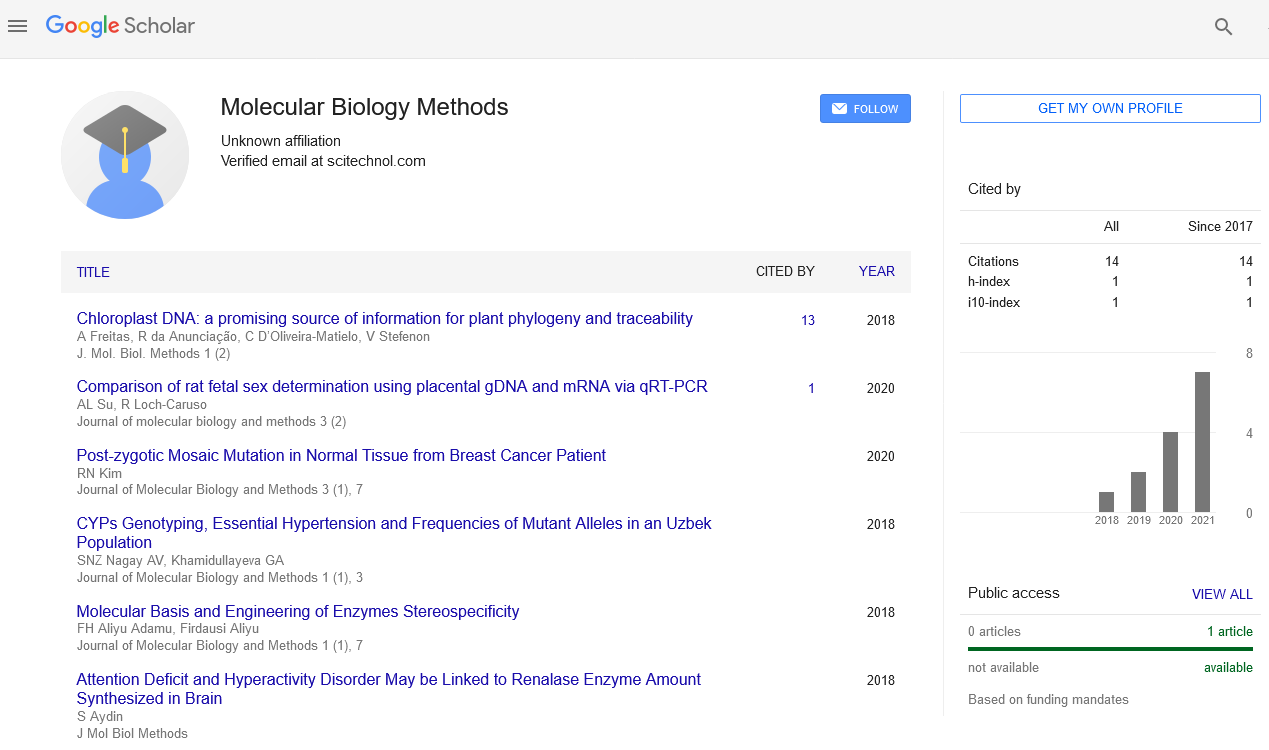Short Communication, J Mol Biol Methods Vol: 6 Issue: 1
Recombinant DNA Technology: A Revolutionary Tool for Biotechnology
Nicole Trent*
1Department of Cellular and Molecular Medicine, The University of Arizona, Tucson, USA
*Corresponding Author: Nicole Trent
Department of Cellular and Molecular Medicine, The University of Arizona, Tucson, USA
E-mail: nicoletrent@arztu.edu
Received date: 20 February, 2023, Manuscript No. JMBM-23-92980;
Editor assigned date: 22 February, 2023, PreQC No. JMBM-23-92980 (PQ);
Reviewed date: 09 March, 2023, QC No JMBM-23-92980;
Revised date: 16 March, 2023, Manuscript No. JMBM-23-92980(R);
Published date: 23 March, 2023, DOI: 10.4172/JMBM.1000126
Citation: Trent N (2023) Recombinant DNA Technology: A Revolutionary Tool forBiotechnology. J Mol Biol Methods 6:1.
Description
Recombinant DNA technology has transformed the field of biotechnology since its inception in the 1970s. The process involves combining DNA fragments from several sources to produce recombinant DNA molecules. This led to the development of several useful products and generated novel fields of study [1]. Recombinant DNA technology has many applications in business, agriculture, and health care. Recombinant DNA technology is a process with numerous steps. The separation of DNA fragments from various sources is the initial stage. In the second step the DNA fragments can be separated from the cells using several techniques, including extraction, purification, and PCR amplification. The third step is to use DNA ligase to join the cut fragments to form recombinant DNA molecules [2,3]. DNA ligase is an enzyme that connects DNA fragments. The introduction of recombinant DNA molecules into host cells is the fourth stage. Host cells can accept foreign DNA and express the genes encoded by the DNA. The final step is to identify and select the cells that have taken up the recombinant DNA [4]. This is accomplished through the use of selectable markers such as antibiotic resistance genes or fluorescent proteins. Recombinant DNA technology has numerous uses in a variety of industries. It is used in medicine to develop therapeutic proteins, vaccines, and gene therapies. The use of recombinant DNA technology to produce therapeutic proteins such as insulin, growth hormone, and clotting factors has revolutionized the treatment of many diseases. Recombinant DNA technology has enabled the creation of vaccines against hepatitis B, the human papillomavirus, and the Human Immunodeficiency Virus (HIV) [5,6]. Recombinant DNA technology is also being used to develop gene therapy, which involves inserting a normal gene into a patient's cells to fix a genetic condition. It can also be used to study mutations and their biological effects, such as the role of specific mutations in disease or abnormal drug response.
Recombinant DNA technology is used in agriculture to produce genetically engineered crops with desired features such as insect, drought, and herbicide tolerance [7,8]. As a result of the introduction of genetically modified crops crop yields have grown, pesticide and herbicide use has decreased, and crop nutritional content has improved. Recombinant DNA technology is used in industry to create enzymes, biofuels, and biodegradable polymers [9,10]. The use of recombinant DNA technology to produce enzymes such as amylase, cellulase, and protease has transformed the food and textile sectors. The use of recombinant DNA technology to produce biofuels such as ethanol and biodiesel has the potential to reduce dependence on fossil fuels [11]. The use of recombinant DNA technology to produce biodegradable plastics offers the potential to minimize plastic waste and pollution.
Conclusion
Recombinant DNA technology is a powerful tool that has revolutionized the field of biotechnology. It can be used in a variety of ways in industry, agriculture, and medicine. The advantages of the technology exceed the risks, despite the ethical concerns that it has raised. Recombinant DNA technology will continue to be an important tool for biotechnology with more study and development. The prospects of recombinant DNA technology are promising, and the potential for new applications and studies is vast.
References
- Johnson IS (1983) Human insulin from recombinant DNA technology. Science 219(4585):632-637
- Chen Z, He Y, Shi B, Yang D (2013) Human serum albumin from recombinant DNA technology: challenges and strategies. Biochim Biophys Acta Gen Subj 1830(12):5515-25.
- Berg P, Mertz JE (2010) Personal reflections on the origins and emergence of recombinant DNA technology. Genetics 184(1):9-17.
- Werck-Reichhart D, Hehn A, Didierjean L (2000) Cytochromes P450 for engineering herbicide tolerance. Trends Plant Sci. (3):116-23.
- Bonny S (2016) Genetically modified herbicide-tolerant crops, weeds, and herbicides: overview and impact. Environ Manage 57(1):31-48.
- Raschdorf F, Dahinden R, Maerki W, Richter WJ, Merryweather JP et al. (1988) Location of disulphide bonds in human insulinā?like growth factors (IGFs) synthesized by recombinant DNA technology. J JBiomed Environ Mass Spectrom 16(1-12):3-8.
- Johnson IS (1982) Authenticity and purity of human insulin (recombinant DNA). Diabetes Care 5(2):4-12.
- Howey DC, Edwin Fineberg S, Nolen PA, Stone MI, Gibson RG et al (1982) The therapeutic efficacy of human insulin (recombinant DNA) in patients with insulin-dependent diabetes mellitus: a comparative study with purified porcine insulin. Diabetes Care 5(2):73-77.
- Quianzon CC, Cheikh I (2012) History of insulin. J Community Hosp Intern Med Perspect 2(2):18701. [Google Scholar]
- Lok AS, Heathcote EJ, Hoofnagle JH (2001) Management of hepatitis B: 2000—summary of a workshop. Gastroenterol 120(7):1828-53.
- Qaim M (2009) The economics of genetically modified crops. Annu. Rev Resour Econ 1(1):665-94.
 Spanish
Spanish  Chinese
Chinese  Russian
Russian  German
German  French
French  Japanese
Japanese  Portuguese
Portuguese  Hindi
Hindi 